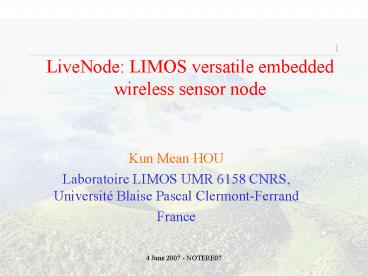LiveNode: LIMOS versatile embedded wireless sensor node - PowerPoint PPT Presentation
1 / 16
Title:
LiveNode: LIMOS versatile embedded wireless sensor node
Description:
... wireless access medium IEEE802.11b (WiFi) or IEEE802.15.4 (ZigBee) connected via ... continuous cardiac arrhythmias detection service. Client/Server ... – PowerPoint PPT presentation
Number of Views:88
Avg rating:3.0/5.0
Title: LiveNode: LIMOS versatile embedded wireless sensor node
1
LiveNode LIMOS versatile embedded wireless
sensor node
- Kun Mean HOU
- Laboratoire LIMOS UMR 6158 CNRS, Université
Blaise Pascal Clermont-Ferrand - France
2
Presentation outline
- Introduction
- Motivations and Objective
- Trend of design and state-of-the art
- Key features of LiveNode hardware module
- LIMOS LiveNode operating system
- Current LiveNode applications Environmental data
collection, smart care and IVC (MobiPlus project) - Conclusion and ongoing work
3
Introduction motivation and objective
- WSN requires technologies from different areas
- Computing
- Basic Software Operating system
- Algorithm Application-specific algorithm
- Hardware Application-specific sensor
architecture - Communication embedded wireless protocol stack
- Sensing ECG sensor, gas sensor (NO2, O3) etc.
- Applications
- Smart home, Smart care, Precision agriculture,
Intelligent transport system, - Industrial and manufacturing automation,
distributed robotics, - Military arena etc.
4
State-of-the art and design trend
- Two main development and design trends
- Off-the-shell design Wireless Sensor node
- µNode, BTnode, TinyNode, EYES, Mica, TmoteSky
- Simple wireless sensor node temperature, light
sensor etc. - Recent wireless node (TmoteSky, iMote )
- 16 or 32 bit microcontroller
- Full compliance IEEE802.14.5 standard
- Short range (200m).
- SoC Wireless Sensor Node.
5
Motivation
- Our main goal is to implement SoC wireless sensor
- A more power-full WS enables to
- Explore more complex applications IVC
- Validate component based concept (hardware and
software). - The key constraints of WSN is energy consumption.
Low energy consumption is indispensable to
implement long life, cost effective, and reliable
WS. - Application-specific unified hardware and
software approach - Algorithm trade-off between complexity,
efficiency and resource consumption, - Hardware component based approach,
- Micro-kernel resource and energy consumption
aware, - Network topology and protocol,
- Sensing.
6
LiveNode hardware module
- Key features of LiveNode
- One AT91SAM7S256 (32 bit RISC ARM7TDMI core)
running at 48MHz, - One standard wireless access medium IEEE802.11b
(WiFi) or IEEE802.15.4 (ZigBee) connected via a
serial port (SPI or RS232), - One standard GSM access medium connected via
UART3, - One GPS receiver connected via UART0,
- One versatile signal conditioner enable to adapt
to different type of sensors such as soil
humidity sensor, ECG signal lead, temperature
sensor, light sensor etc. - Three 8 bit extension connectors SPI etc.
2006
2002
1999
7
LiveNode Energy Consumption
- The LiveNode PCB board is designed to be equipped
with different wireless access medium - Short range LiveZigBeeNode 70mA (200m)
- Long range LiveZigBeeNode 270mA (1500m)
- Short range LiveWiFiNode 400mA (200m)
LiveZigBeeNode
LiveWiFiNode
8
LiveNode and Component based
- Component based concept scalability,
fault-tolerance and flexibility. - LiveZigBeeNode, LiveWiFiNode and LiveGPRSNode
WS
SPI bus
RS232
Master LiveNode1
Slave1 LiveNode3
Slave0 LiveNode2
I²C bus
9
LIMOS LiveNode operating system
- Most of the existing wireless sensor nodes run
three types of real-time operating systems one
is based on event driven (TinyOS and Contiki), - The second one is based on classical
multi-threading (NutOS and MANTIS). - The third one, AmbientOS is based on data centric
multi-tasking. - Complex real-time application
- Component based concept implementation.
10
LIMOS LIghtweight Multi-threading Operating
System
- Key features of LIMOS
- LIMOS combines the advantages of event driven and
multi-threading concept. Thus LIMOS can support a
large variety of WSN applications ranging from
simple single-task to multi-task hard real-time
applications. - LINDA concept ease implementation of component
based concept.
11
LiveNode platform application MobiPlus
- Presently LiveNode is used as a prototype to
experiment three projects in different areas
inter vehicle communication (MobiPlus project),
environmental data collection (Net-ADDED European
project) and smart care (LiveCare).
12
LiveNode Application environmental data
collection (precision agriculture)
13
Smart care STAR project
- STAR Project
- Remote real-time continuous cardiac arrhythmias
detection service - Client/Server Architecture
14
MobiPlus Project
Gas Sensor
WS
Disabled passengers
RFID
GPS
15
Conclusion and ongoing work
- LiveNode platform is used in different
applications IVC, environmental data collection,
smart care etc. The obtained results are
satisfied, and meet the application requirement
constraints. - LiveNode platform is also used to valid component
based concept and evaluate the resource
consumption of IVC and smart home/care
applications. - In collaboration with other laboratories, we
start to implement an SoC WS dedicated to smart
home/care MEM and wireless access medium.
16
- Thank you for your attention!



















![ESRT: Event-to-Sink Reliable Transport in Wireless Sensor Networks[Sankarasubramaniam et. al, ACM MobiHoc 2003] PowerPoint PPT Presentation](https://s3.amazonaws.com/images.powershow.com/6075243.th0.jpg?_=20201118051)











